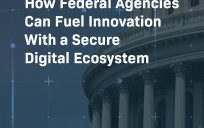This blog post is an excerpt from GovLoop’s recent industry perspective “How to Embrace Cloud as a Business Model.” Download the full report here.
Before moving to the cloud, agencies must establish why they are adopting it. Are they hoping to cut costs, reduce their IT infrastructure investments, free up staff to work on priority projects or all of the above?
Once agencies establish their goal, they should also consider these key questions to determine which model is best to use: public, private or hybrid.
1. Where do you want the technology to live?
One of the first questions to consider is whether you want technology to physically reside in your agency’s data center, or if you’re open to other options, such as using a vendor’s facility. Maybe there’s limited space in your data center and you no longer want to own hardware and software, or maybe you want access to advanced technology capabilities at a more modern data center. If that’s the case, a hosted facility managed by a cloud vendor could be a viable option. Note that concerns about data security and data custody will also shape your decision about where the technology will reside.
2. Who do you want to operate the technology?
There are several considerations to make when deciding who will operate the technology. If you want your internal staff to do it, first determine whether you have enough employees with the right skills. If you’d rather have your employees focus on other tasks, you may decide to use a third-party vendor to manage your cloud environment remotely or onsite. Another alternative is using your staff but supplementing your workforce with contracted assistance. Also consider whether your agency is required to use U.S. citizens to perform these duties.
3. How do you want to pay for cloud services?
People often say they want to buy a cloud, but what does that actually mean? Most often, they mean they don’t want to pay for the technology with capital expenditure or Capex dollars budgeted for buying and upgrading IT equipment. They would rather pay for access to IT resources as they consume them, which is a fundamental tenet of the cloud business model. This is often referred to as an operational expenditure or Opex model. But depending on which vendor solution you use, there are some nuances to keep in mind.
When most public cloud providers say they allow agencies to pay for usage, what they really mean is agencies will pay for what has been provisioned or allocated to them, said Ray McCay, Vice President of Solution Strategy at ViON. They don’t know how much of those resources are actually being used, but agencies are being charged for what they have been assigned whether they actually use it or not. The other option, which ViON provides, is actually paying for the resources that are used — not just provisioned. “We will provide you that option because we believe it gives you the most flexibility to control your expenses and match your payments to actual business cycles, whether usage is going to go up and down.
4. Who is using the technology?
Is technology shared among many agencies and therefore best suited for a public, multi-tenant cloud? Or is your agency the only one using the technology, thus allowing you the benefit of leveraging a private cloud? This is important from a regulatory standpoint, because private cloud deployments intended for a single agency and implemented fully within federal facilities are not subject to Federal Risk and Authorization Management Program (FedRAMP) regulations, McCay said. Shared cloud environments introduce new risks and must meet the extensive requirements set by FedRAMP.
For a growing number of agencies, hybrid clouds provide the best of what public and private clouds have to offer. This option allows them to keep more sensitive information in a private cloud, while making less sensitive data available via public cloud. Market research strongly predicts that hybrid cloud / multi-cloud environments will be the most prevalent cloud model in deployment.
5. How do you want your users to access the technology?
One of the reasons users are dissatisfied with IT is the amount of time it takes to physically turn on the technology for use. They want to speed up and simplify that process. In the case of a public cloud environment, setup is almost instantaneous. You can use your credit card and buy a virtual machine, and it’s up and running in minutes. People value the ease of an automated service that they can self-provision.
But the problem for organizations is that easy access to resources can lead to shadow IT, where organizations don’t know what applications they own, where they reside, who’s using them and how they are paying for the resources, McCay said. One alternative is to use a user provisioning desk, similar to a help desk, that helps users gaining access to resources and provides monitoring control to ensure purchase are in line with agency standards. ViON can support either option. “Our focus is ensuring your cloud deployment meets mission success,” he said.






Leave a Reply
You must be logged in to post a comment.